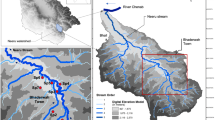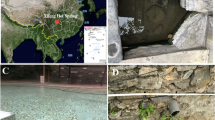Abstract
Hot springs have been known for a long time over the world. They are used for curative action and healing properties linked to their physical and chemical characteristics. In order to best use the opportunities provided by globalization, Algerian authorities try to modernize its social and economic policies investing mainly in geothermal resources recognizing that the hot springs have rich potential to develop ecotourism. Nevertheless, the use of thermal waters requires nowadays a prior characterization to study their quality. The mineral bacteriology assessment Type 0, Type 1, and Type 2 are used to assess the microbiological quality. It consists of the enumeration of total aerobic flora (37 \(^{\circ }\hbox {C})\), Coliforms and Escherichia coli, intestinal enterococci, sulphite-reducing bacteria spores, Pseudomonas aeruginosa, Legionella and pathogenic staphylococci using standard microbiological techniques and culture method. The sixteen thermal springs mainly from the eastern part of Algeria, whose water temperature ranges between 39 and 93 \(^{\circ }\hbox {C}\), were also subjected to hydrochemical and gamma spectrometric methods. The obtained results showed the average number of total aerobic flora ranging from 0 to \(4\times 10^{4}\) CFU/mL and the presence of Staphylococcus aureus species. Four springs revealed the presence of Legionella. Two springs among the four also exhibited a significant contamination by enterococci. The conductivity ranged from 296 to 48,100 \(\upmu \)S/cm. The thermal waters are rich in minerals representing the evaporite deposits leaching with high temperatures and significant mineralization in both major and minor elements. Measured activities of \(^{40}\)K ranged from 360 to 6,330 mBq/L. For the \(^{238}\hbox {U}\) series, \(^{226}\hbox {Ra}\) activity concentrations varied from 8 to 6,110 mBq/L. Activity concentrations determined for \(^{137}\hbox {Cs}\) revealed that only one thermal spring contained this radionuclide with concentration of 95 mBq/L.



Similar content being viewed by others
References
Althaus H (1986) Legionella in swimming pools. A B Arch des Badewesens 38:242–245
Amrani D (2002) Natural radioactivity in Algerian bottled mineral waters. J Radioanal Nucl Chem 252:597–600
Améon R (2003) Le radon dans les stations thermales une source d’exposition aux rayonnements ionisants. Radioprotection 38(2):201–215
Barragàn RRM, Birkle P, Portugal ME, Arellano GVM, Alvarez RJ (2001) Geochemical survey of medium temperature geothermal resources from the Baja California Peninsula and Sonora, Mexico. J Volcanol Geotherm Res 110:101–119
Bornstein N, Surgot M, Fleurette J (1992) Bilan d’activité du centre national de référence pour les légionelloses depuis 11 ans. Bull épidémiologique hebdomadaire. Direction générale de la santé 3: 9–12
Bouanane-Darenfed A, Fardeau ML, Grégoire P, Manon J, Kebbouche-Gana S et al (2011) Caldicoprobacter algeriensis sp. nov. a new thermophilic anaerobic, xylanolytic bacterium isolated from an Algerian hot Spring. Curr Microbiol 62:826–832
Brillanceau F, Hubert P (1998) Rapport du groupe d’expert sur l’exposition naturelle renforcée aux rayonnements ionisants auprès du Comité Interministériel de Transposition. Directive Euratom 96/29. Radioactivité naturelle groupe d’expert no 2
Bryan TS (2000) The geyser fields of the world. Yellowstone. Interpretive Training Presentation
Celico F, Varcamonti M, Guida M, Naclerio G (2004) Influence of precipitation and soil on transport of fecal enterococci in fractured limestone aquifers. Appl Environ Microbiol 70(5):2843–2847
Currens J (2002) Changes in groundwater quality in a conduit-flow-dominated karst aquifer, following BMP implementation. Environ Geol 42:525–531
De Master DJ, McKee BA, Nittouer CA, Qian JC, Cheng GD (1985) Rates of sediment accumulation and particle reworking based on radiochemical measurements from continental shelf deposits in the East China Sea. Cont Shelf Res 4:143–158
DGS (2000) Circulaire relative à la gestion du risque microbien lié à l’eau minérale dans les établissements thermaux. VS 4(2000): 336
DGS (1999) Recommandations relatives à la gestion du risque microbien lié à l’eau minérale dans les établissements thermaux. Bureau de l’Eau Conseil Supérieur d’Hygiène
Dib H (1985) Le thermalisme de l’Est Algérien. Thèse de Doctorat \(3^{\grave{e}{\rm me}}\) cycle. Ph.D. thesis, University of Science and Technology Houari Boumedienne, USTHB, Algiers
Drew D, Hötzl H (1999) Karst hydrogeology and human activities impacts, consequences and implications. Brookfield Balkema Publishers, Rotterdam 332p
El Daoushy F (1988) The Pb-210 global cycle: dating and tracing applications. In: Garcia Léon M, Madurga A (eds) Low-level measurements and their applications to environmental radioactivity. World Scientific, Singapore, pp 224–273
Erentöz C, Ternek Z (1968) Les sources thermominérales de la Turquie et l’étude de l’énergie géothermique. Bull Miner Res Explor Inst Turkey (Foreign edition) 7:1–59
Florou H, Kritidis P (1992) Gamma radiation measurements and dose rate in the coastal areas of a Volcanic Island, Aegean Sea, Greece. Radiat Prot Dosim 45(1):277–279
Ford D, Williams P (2007) Karst hydrogeology and geomorphology. Wiley, New York
Galle P (1997) Toxiques nucléaires, \(2^{\grave{e}{\rm me}}\) edn. Masson, Paris
Gleeson C, Gray N (1997) The coliform index and waterborne disease. E and FN Spoon, 194p. In: Fiche Entérocoques et streptocoques fécaux, pp 49–53. Groupe scientifique sur l’eau Institut national de santé publique du Québec, Québec
Groothuis DG, Havelaar AH, Veenendaal HR (1985) A note on Legionella in whirlpools. J Appl Bacteriol 58(5):479–481
Guidelines for Canadian Drinking Water Quality (2009) Guideline Technical Document Radiological Parameters. Federal-Provincial-Territorial Committee on Health and the Environment. Ottawa, Ontario. Cat. H128–1/10-614E-PDF
Hakam OK, Choukri A, Reyss JL (2000) Comparaison des activités des isotopes de l’uranium et du radium dans quelques échantillons d’eau de puits et de sources thermales au Maroc. Revue des sciences de l’eau 13:185–192
Heijer CDJ, Bijnen EME, Paget WJ, Pringle M, Goossens H, Bruggeman CA, Schellevis FG, Stobberingh EE (2013) Prevalence and resistance of commensal Staphylococcus aureus, including methicillin—resistant S.aureus in nine European countries: a cross-sectional study. Lancet Infect Dis 13(5):409–415
Hesham AN, Nahed IM, Elakhras A, Wasfy R, Abu Baker R (2012) Skin colonization by superantigen-producing Staphylococcus aureus in Egyptian patients with atopic dermatitis and its relation to disease severity and serum interleukin-4 level. Int J Infect Dis 16(1):e29–e33. doi:10.1016/j.ijid.2011.09.014
Huang SW, Hsu BM, Huang CC, Chen JS (2011) Utilization of polymerase chain reaction and selective media cultivation to identify Legionella in Taiwan spring water samples. Environ Monit Assess 174:427–437. doi:10.1007/s10661-010-1467-7
IAEA (2010) Analytical methodology for the determination of radium isotopes in environmental samples. Analytical Quality in Nuclear Applications No. IAEA/AQ/19, Vienna
Issaadi A (1992) Le thermalisme dans son cadre géostructural, apports à la connaissance de la structure profonde de l’Algérie et de ses ressources géothermales. Thèse de doctorat d’état. IST, USTHB
Journal Officiel de la République Algérienne N\(^{\circ }\)27 (2006) Annexe III: caractéristiques microbiologiques des eaux minérales et thermales
Journal Officiel de la République Algérienne N\(^{\circ }\)18 (2011) Paramètres de qualité de l’eau de consommation humaines
Kecha M, Benallaoua S, Touzel JP, Bonaly R, Duchiron F (2007) Biochemical and phylogenetic characterization of a novel terrestrial Hyperthermophilic archaeon pertaining to the genus Pyrococcus from an Algerian hydrothermal hot spring. Extremophiles 11:65–73
Kedaid FZ (2007) Database of the geothermal resources of Algeria. Geothermics 36:265–275
Keller DW, Hajjeh R, De Maria A, Fields BS, Pruckler JM et al (1996) Community outbreak of Legionnaires’ disease: an investigation confirming the potential for cooling towers to transmit Legionella species. Clin Infect Dis 22:257–261
Kelly W, Panno S, Hackley K, Martinsek A, Krapac I et al (2009) Bacteria contamination of groundwater in a mixed land-use karst region. Water Qual Expo Health 1:69–78
Labidi S, Mahjoubi H, Essafi F (2010) Natural radioactivity levels in mineral, therapeutic and spring waters in Tunisia. J Radiat Phys Chem 79:1196–1202
Leclerc H, Da Costa MS (1998) Microbiology of natural mineral waters. In: Senior DAG, Ashurst PR (eds) Technology of bottled water. Sheffield Academic Press Ltd, Sheffield, pp 223–273
Lopoukhine M (2001) Gisements d’eau minérale et légionelles. BRGM, Orléans
Marovic G, Sencar J, Franic Z, Lokobauern N (1996) Radium-226 in thermal and mineral springs of Croatia and associated health risk. J Environ Radioact 33(3):309–317
OMS (2000) Directives de qualité pour l’eau de boisson: critères d’hygiène et documentation à l’appui, \(2^{\grave{e}{\rm me}}\) édn. OMS, Genève
Piper AM (1944) A graphical procedure in the geochemical interpretation of water-analysis. Trans Am Geophys Union 25:914–928
Pouget L, Chouchak D (1923) Radioactivité des eaux minérales d’Algérie. C R Acad Sci (Paris) 177:1112–1114
Rémy ML, Lemaître N (1990) Eau minérale et radioactivité, réglementation et textes. Note technique N\(^{\circ }\)15. Extrait de l’eau minérale et radioactivité-Hydrogéologie 4:267–278
Rodenas C, Gomez J, Soto J, Maraver F (2008) Natural radioactivity of spring water used as spas in Spain. J Radioanal Nucl Chem 277(3):625–630
Saibi H (2009) Geothermal resources in Algeria. Renew Sustain Energy Rev 13:2544–2552
Selinus O, Alloway B, Centeno JA, Finkelman RB, Fuge R, Lindh U et al (2005) Essentials of medical geology: impact of the natural environment on public health. Elsevier Academic Press, New York
Singh KP (2014) Water quality and health issues in south-west parts of Punjab state, India. Sharma V (eds) Water and health, issues. doi:10.1007/978-81-322-1029-0_23, Springer India
Tazir M (2009) Rapport d’activités de l’Institut Pasteur d’Alger. IPA, Algiers 296 p
UNSCEAR (2000) Exposures from natural radiation source. Annex B. United Nations, Forty-ninth session, Vienna
USEPA (2000) National primary drinking water regulations: ground water rule; proposed rules. Fed Regist (National Archives and Records Administration) 30(194–30):274
Verdeil P (1982) Algerian thermalism in its geostructural setting. How hydrogeology has helped in the elucidation of Algerian’s deep seated structure. J Hydrol 56:107–117
WHO (2008) Guidelines for drinking-water quality, recommendations, 3rd edn. World Health Organization, Geneva
Author information
Authors and Affiliations
Corresponding author
Rights and permissions
About this article
Cite this article
Amarouche-Yala, S., Benouadah, A., el Ouahab Bentabet, A. et al. Physicochemical, Bacteriological, and Radiochemical Characterization of Some Algerian Thermal Spring Waters. Water Qual Expo Health 7, 233–249 (2015). https://doi.org/10.1007/s12403-014-0130-x
Received:
Revised:
Accepted:
Published:
Issue Date:
DOI: https://doi.org/10.1007/s12403-014-0130-x




